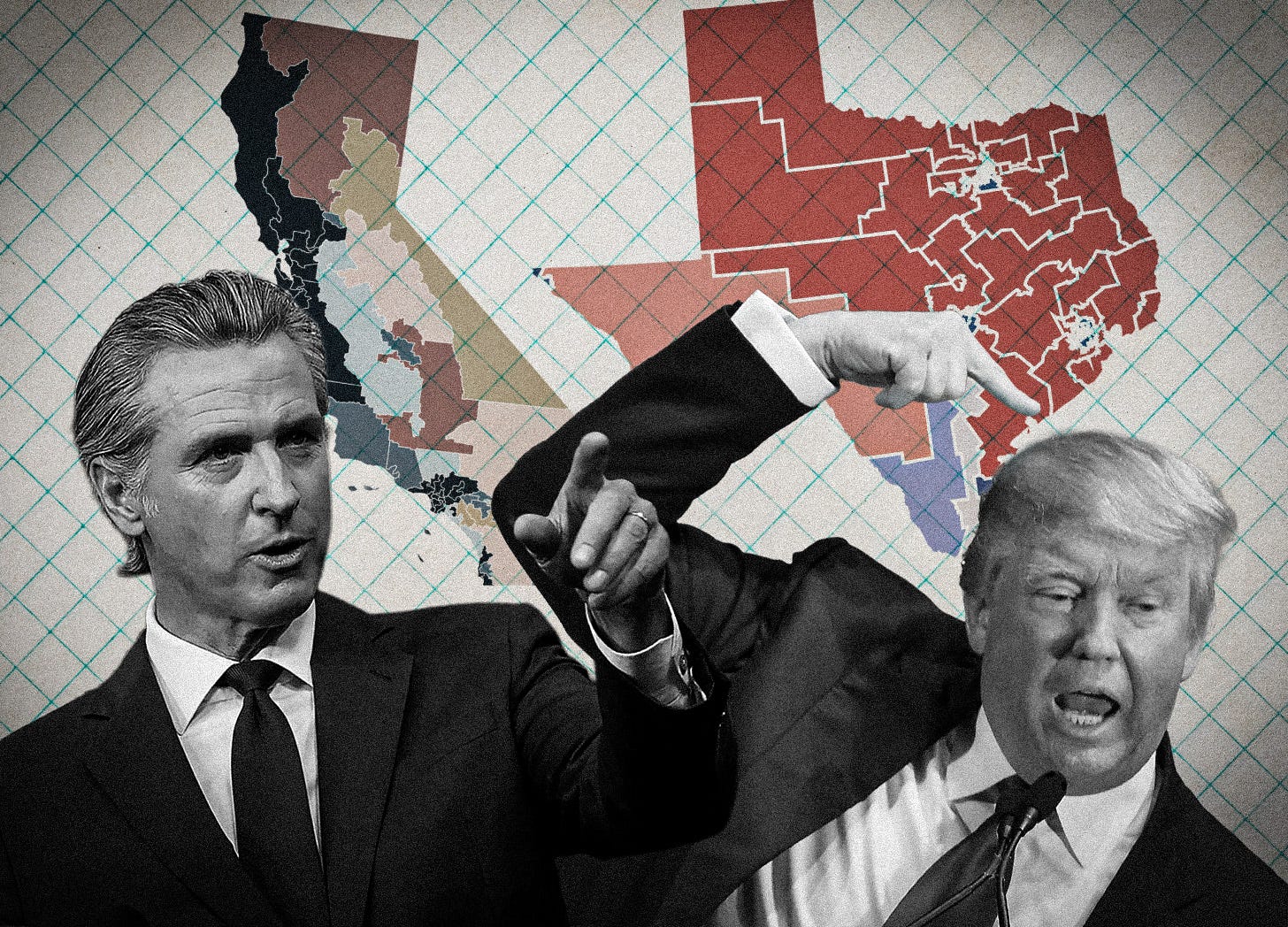Want to End the Gerrymandering Wars? Embrace Proportional Representation
Trump has triggered a particularly fierce round, but the logic of war is inherent in a winner-take-all system
Earlier this month, at Donald Trump’s urging, Texas enacted a mid-decade redistricting plan that eliminates five Democratic congressional seats. The push hasn’t stopped with Texas—the White House has launched a full-court press in Republican-controlled states, including Indiana, Missouri, and North Carolina, which are now moving forward with their own redistricting plans.
The maneuver is unusual in timing and unprecedented in scope, aimed squarely at shaping the 2026 midterms, when Democrats are favored to retake the House. By dispersing Democratic voters across districts engineered for Republican advantage, Trump is trying to put his thumb on the scale before a single ballot is cast.
California has responded in kind. Gov. Gavin Newsom has signed legislation placing on the Nov. 2025 ballot a proposal to redraw the state’s map, converting five Republican districts into Democratic ones. Unlike Texas, the California measure will have to go for a vote because it will temporarily sideline the state’s independent redistricting commission, which is written into the state constitutions. It is polling 20 points ahead, so is almost certain to pass. Supporters argue that if one party can tilt Congress through electoral cartography, their opponents cannot afford to stand down. In this environment, restraint would be unilateral disarmament.
At the end of the day, all this tit-for-tat wrangling might not even change the overall outcome of the midterms. The current Republican majority in the House is razor-thin. At Trump’s last midterm election, in 2018, Democrats won the majority by more than 30 seats. If current trends on Trump’s approval ratings and the generic congressional ballot hold (or accelerate), eking out a net gain of two or three seats with new maps, or even four or five on the high end, will not save the Republicans. It could make a difference—it’s possible that the election might be that close—but it probably won’t.
Still, the damage to representative government will be real, as red states are shorn of their Democratic representatives and vice versa in blue states. There will be even fewer competitive races. Public confidence will continue to erode. Voters will feel more intensely that Congress doesn’t really answer to them, that the whole game is corrupt and rigged. Nobody will be better off; the whole system will just be worse.
Though the current fight is a new escalation, the basic cycle of action and reaction—aka the gerrymandering wars—had been going on for decades. It is the logical result of a system where the shape of the map decides the balance of power. As long as representation depends on single-member, winner-take-all districts, the incentive to manipulate districts will remain irresistible. The only way to remove that temptation is to make the map irrelevant, and the best way to do that is by moving to a system of proportional representation.
The Usual Fixes Aren’t Enough
Reformers have tried to blunt the excesses of gerrymandering through independent commissions and litigation. Some states, including California and Michigan, have seen modest success. Courts occasionally step in to strike down the most distorted maps, as recently happened in Utah. These efforts make the process look cleaner, but they cannot change the basic mathematics of single-member districts.
Geography alone produces disproportional outcomes: deep blue urban areas tend to be more overwhelmingly Democratic, with the GOP vote in the low teens or falling into the single digits. But safely Republican-held exurbs and rural areas tend to still have relatively more Democratic voters, in the 20s or 30s. In other words, Democrats are inefficiently distributed. More of their votes are “wasted,” either because they are simply running up the score in a blue district, which gets them no additional seats, or because they’re getting 20-40% of the vote in a district that’s still safely Republican. When done deliberately, this is the basic gerrymandering tactic of “packing and cracking.” In effect, Democratic voters are naturally more packed and cracked, even if the map isn’t intentionally drawn to favor the Republicans.
Given the constraints of America’s political geography, it simply isn’t possible to draw districts where more than a tiny handful will be competitive between the two parties. But it’s not just Democrats who suffer: Republicans in blue states and districts are also locked out of having a voice on Capitol Hill.
In North Carolina, a 50–50 vote split can produce a delegation with 10 Republicans and only four Democrats. In Massachusetts, Republicans receive about a third of the statewide vote yet hold no House seats at all. These imbalances are not aberrations; they are the predictable consequence of a winner-take-all system in a country where voting is heavily polarized along the lines of population density (and race, the two being heavily correlated).
Litigation offers no stable remedy. In Rucho v. Common Cause (2019), the Supreme Court declared partisan gerrymandering beyond the reach of federal courts. State courts vary in how aggressively they intervene, and their rulings often reflect their own partisan makeup. At best, the judiciary offers occasional relief. At worst, it entrenches partisan advantage.
The lesson of the current standoff is that the problem is not only bad actors or bad maps, even though we are seeing plenty of both. It is the structure of the system itself.
Proportional Representation to the Rescue
Proportional representation addresses these flaws at the root. Instead of slicing states into single-member districts, proportional representation uses larger, multi-member districts where seats are distributed according to vote share. If Democrats win 45% of the vote in Texas, they earn about 45% of Texas’s seats. If Republicans win a third of the vote in California, they secure about a third of California’s delegation.
The effect is immediate: the shape of the map no longer determines the outcome. Gerrymandering becomes pointless, because the competition is no longer just to get a plurality of the vote within a district. Instead, vote swings everywhere have the ability to flip seats in equal measure.
The benefits extend well beyond neutralizing gerrymanders. Proportional representation broadens representation in the House. In our current system, a party that wins a large fraction of the vote in a state may receive no seats at all. Under proportional representation, those voters are represented in proportion to their numbers. That means more choices for voters, fewer “wasted” ballots, and a Congress that better reflects the diversity of American opinion.
It also reshapes political incentives. Winner-take-all districts encourage candidates to focus on the narrow slice of partisan voters who control primaries, driving polarization. Proportional representation creates pressure to build coalitions across differences. In countries like Germany and New Zealand, coalition governments are the norm, and electoral thresholds (a 5% minimum to win seats in both countries) ensure there isn’t too much chaotic fracturing of the parties. Politics can be messy, but it rewards negotiation and pragmatism over brinkmanship.
Most importantly, proportional representation restores legitimacy. Millions of Americans today live in “safe” districts where their votes rarely matter. A Democrat in West Texas or a Republican in San Francisco knows their ballot has little impact on representation. That alienation feeds distrust and cynicism. Under proportional representation, every vote contributes equally to representation, no matter where it is cast. Many more Americans would have a representative they actually voted for.
The Founders Would Have Approved
Far from being alien to the American tradition, proportional representation is consistent with the vision of the Founders. John Adams wrote:
The principal difficulty lies, and the greatest care should be employed in constituting this Representative Assembly. It should be in miniature, an exact portrait of the people at large. It should think, feel, reason, and act like them. That it may be the interest of this Assembly to do strict justice at all times, it should be an equal representation, or in other words equal interest among the people should have equal interest in it.
That is precisely what proportional representation achieves: a legislature that mirrors the public in its variety and proportions.
The tools of proportionality themselves are deeply rooted in American constitutional history. The mathematical methods now associated with proportional representation—such as the d’Hondt and Hare systems—were originally devised for congressional apportionment by population. Thomas Jefferson, Alexander Hamilton, and others each proposed competing formulas to allocate seats fairly among the states. In other words, long before proportional representation on the basis of parties was clearly conceived, American statesmen grappled with how best to match votes to representation.
Ironically, the move to single-member districts in the Apportionment Act of 1842 was itself an attempt to promote proportionality. It was intended to stop states from electing their entire House delegations at-large (that is, all members elected together statewide) using a winner-take-all system known as bloc voting. The use of bloc voting would reliably produce clean sweeps for the larger party, winning all the state’s seats, and leave the minority party with no representation at all. By dividing states into districts, Congress hoped to ensure fairer outcomes, more proportional to the votes cast.
But what was once a safeguard has now become a vulnerability. Gerrymandering allows states to achieve nearly the same result as those old statewide slates: locking out large segments of their electorate from meaningful representation. The same dynamic played out in the Electoral College. James Madison wanted a constitutional amendment requiring electors to be chosen from single-member districts, to prevent states from submitting winner-take-all slates. Instead, driven by partisan incentives, most states adopted precisely that approach, giving us the Electoral College as we know it today (with two small exceptions in Maine and Nebraska). Congressional gerrymandering effectively replicates the same winner-take-all logic, letting the majority party in a state lock out the minority.
Proportional representation solves this problem. It ensures that Republicans in deep-blue states, Democrats in deep-red states, and independents everywhere all have their voices reflected in Congress according to their actual support. Representation becomes not the product of map-drawers’ choices, but the electorate’s.
A Democracy Worth Having
The Texas gerrymander and California’s response underscore the stakes. Political parties can’t be expected to refrain when the balance of Congress hinges on district lines. But over time, this cycle erodes the legitimacy of representation. Elections become contests of cartography rather than persuasion, and voters lose confidence that outcomes reflect their choices.
Proportional representation ends the gerrymander wars by taking away the weapon altogether. It ensures that vote shares translate into seat shares, regardless of geography. It opens Congress to new voices, incentivizes cooperation, and makes every vote matter.
Crucially, adopting proportional representation would not require a constitutional amendment, with its near-impossible supermajority thresholds. Congress could simply amend the law requiring single-member districts to instead specify multi-member proportional systems for electing each state’s members of the House, using its constitutional power over congressional elections. One version of this proposal, albeit flawed, has already been filed, the Fair Representation Act, which would require each district to elect three to five representatives.
We often treat electoral rules as fixed, but they are choices. The U.S. chose single-member, winner-take-all districts in the 19th century. Today, that choice is fueling dysfunction and distrust. We can choose differently. And in doing so, we would not be abandoning the Framers’ vision but fulfilling it.
The tyranny of the map has gone on long enough. A healthier democracy—one that reflects the pluralism of its citizens rather than the skill of its mapmakers—requires proportional representation.
© The UnPopulist, 2025
Follow us on Bluesky, Threads, YouTube, TikTok, Facebook, Instagram, and X.
We welcome your reactions and replies. Please adhere to our comments policy.









Many people have various ideas how this should be reformed but it is an absolute imperative that the monster of gerrymandering must be slain and the utterly unnecessary practice of district drawing that makes it possible must be eliminated altogether.
Start with ranked-choice voting, which could be done state-by-state.